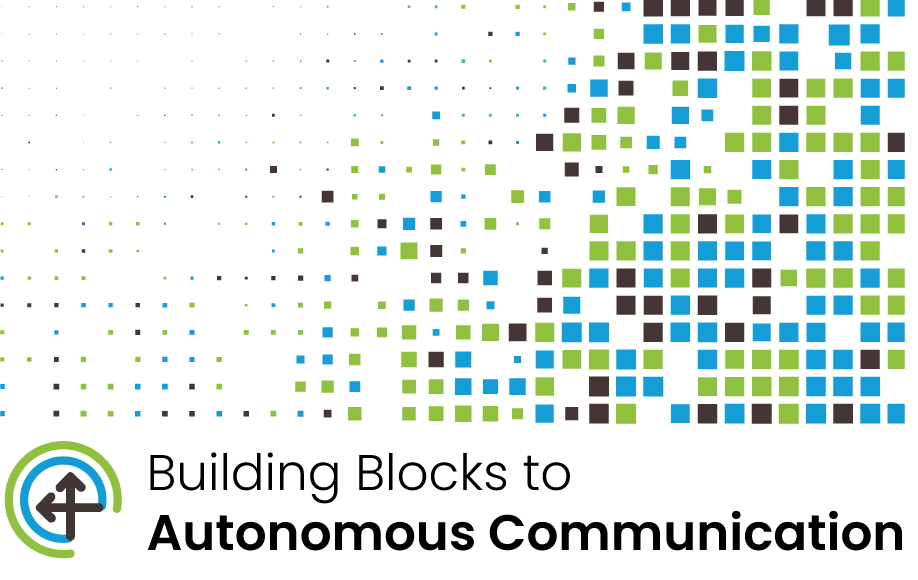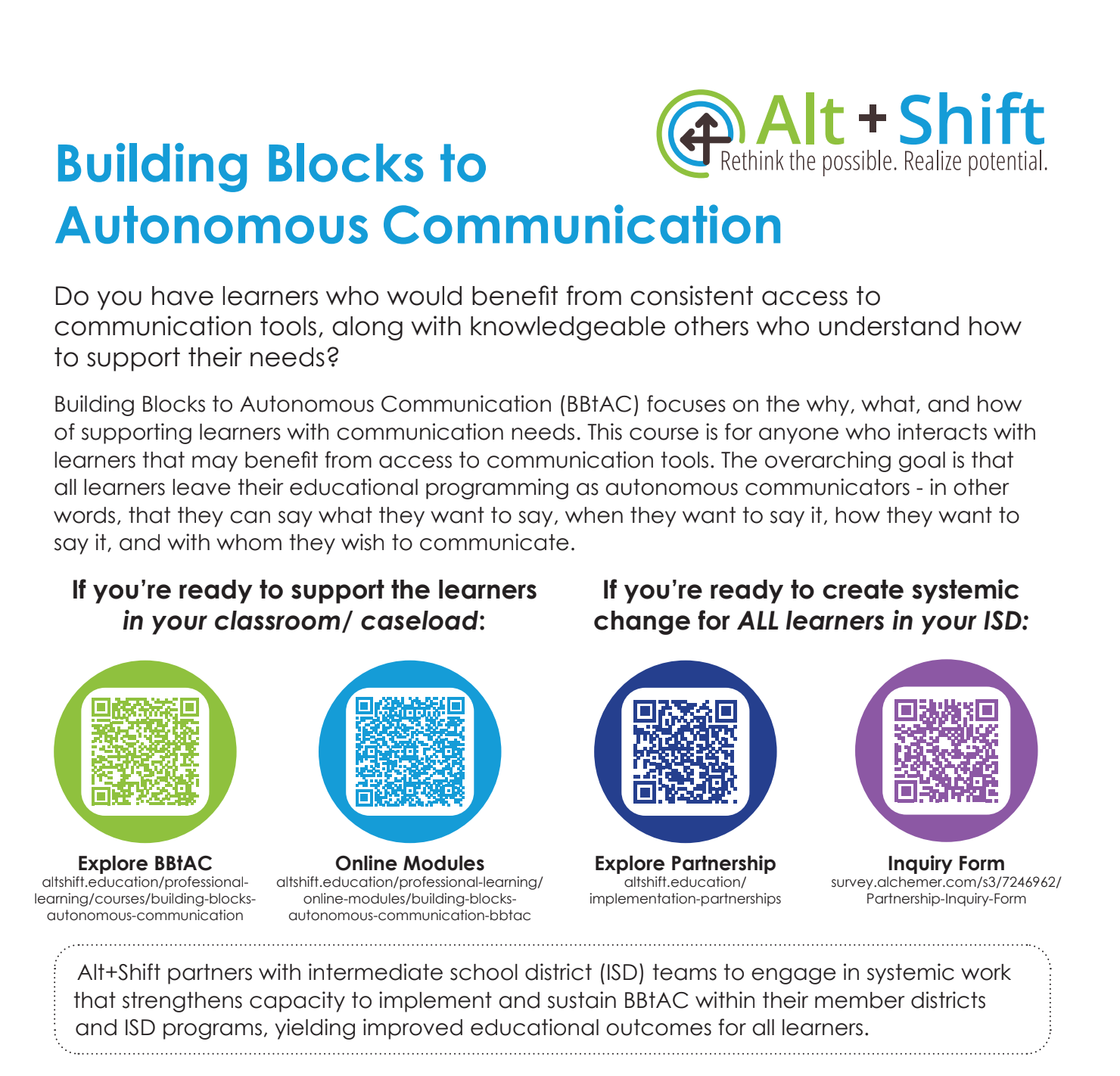Building Blocks to Autonomous Communication

Communication is a prerequisite for teaching and learning. Building Blocks to Autonomous Communication focuses on the what, why, and how of supporting learners with Complex Communication Needs (CCN). The overarching goal is that individuals with CCN leave their educational programming as autonomous communicators - in other words, that they can say what they want to say, when they want to say it, how they want to say it, and with whom they wish to communicate.
This professional learning opportunity is designed for educators who support learners with complex communication needs including:
- classroom teachers
- paraprofessionals
- ancillary staff
- administrators
The Building Blocks
Each building block is designed to focus on a targeted set of knowledge and skills. This knowledge and set of skills will enable educators to provide effective instruction to individuals with complex communication needs.
In this professional learning opportunity, participants will learn:
- How to embed evidence-informed Augmentative and Alternative Communication (AAC) practices with all learners
- Tools and strategies to implement new learning and practices
- Create systems to support the sustainability of the effort
In preparation for training, partnership sites will complete a brief survey. Based on the results, sites will receive training and implementation support in some, most, or all of the building block areas. Alt+Shift will co-construct the training and implementation supports with the partnership site.
This professional learning opportunity is tailored to the needs of the partnering ISD. It is composed of content from Assistive Technology (AT) Journey, Foundations of Communication, Pragmatic Organization Dynamic Display (PODD), Teaching Movements for Communication, and Comprehensive Literacy for Autonomous Communication.
Block 1: Understanding the Fundamentals of AAC
Goal: In this block, participants will learn about the fundamentals of Augmentative and Alternative Communication (AAC) that lead to individuals becoming autonomous communicators.
Objectives:
Participants will:
- Describe autonomous communication
- Debunk common AAC myths
- Explain who would benefit, what AAC is, and why it is beneficial for learners
Block 2: Considering Assistive Technology (including AAC) for Your Learner
Goal: In this block, participants will learn the components of a multidisciplinary team approach to the Assistive Technology [AT (including AAC)] assessment process.
Objectives:
Participants will:
- Identify the components of the an AT and/or AAC assessment process (including consideration, selection, and implementation)
- Explain the benefits of utilizing a team based approach
- Determine the next actionable steps for improving their AT assessment process
Block 3: Building your Communication Partner Toolbox
Goal: In this block, participants will learn strategies to support AAC users as they become more competent communicators.
Participants will:
- Describe effective practices of communication partners
- Create a plan to improve all environments for communication
Block 4: Exploring Non-Electronic to Electronic Communication Tools
Goal: In this block, participants will learn about the importance of demonstrating language through non-electronic and electronic communicative means.
Participants will:
- Explain the differences and importance of non-electronic and electronic AAC systems
- Describe the difference between core and fringe vocabulary
- Explain the components of AARCH (a framework for thinking about and implementing AAC including Autonomy, Accessibility, Requirements, Competence, and Habits)
- Practice using low tech AAC supports (ex: core boards, PODD communication books, etc)
Block 5: Supporting AAC Users with Alternative Access
Goal: In this block, participants will learn how to support AAC users with complex physical bodies as they develop language skills through alternative access (i.e., using a method other than pointing to select words, such as eye gaze, partner assisted scanning, or using a switch).
Participants will:
- Describe the differences between direct select, eye gaze, and partner assisted scanning (visual, auditory, and visual+auditory)
- Identify characteristics of individuals who may benefit from access to alternative means of communication
- Explain ten (10) key movement issues that underlie all functional movement
Block 6: Developing Literate AAC Users
Goal: In this block, participants will receive an overview of strategies that support daily, comprehensive literacy instruction for individuals with significant disabilities.
Participants will:
- Identify the behaviors and understandings of emergent versus conventional literacy learners
- Describe the instructional strategies of emergent versus conventional literacy approaches
- Reflect upon the conditions for learning in their classroom environments
Block 7: Communicating Outside of the Classroom
Goal: In this block, participants will gain strategies and skills for supporting AAC users beyond the classroom into their home and community environments.
Participants will:
- Explain the importance of educating all community members on how to support AAC users
- Describe strategies for partnering with families to support communication within the home and community environments
Explore the Practice Profile
This practice profile outlines the key components of successful implementation of the information in this course. It highlights evidence-based practices and describes the essential activities that support each component. Practice profiles help teams and individuals assess their current practices, identify areas for growth, and set goals. They can improve consistency among educators, track progress, and guide system improvements.
Why Try Something New?
Many professionals engage in AT (including AAC) learning opportunities. These trainings may result in splinter skills; having the information is one thing, but applying it to help AAC users is different. This model pulls it all together and highlights:
- All educators should believe that individuals with CCN can and will be autonomous communicators.
- All educators should utilize a team-based approach to teach language to individuals with CCN.
- All AAC users are eligible for a robust AAC system. There are no prerequisites.
- Individuals with CCN can only be autonomous if they can read and spell letter-by-letter.
- Educators and families should support, educate, and advocate for AAC users beyond the classroom.
Evidence Base
- Leading the Way to Excellence in AT Services: A Guide for School Administrators
- Quality Indicators for Assistive Technology (QIAT) for Consideration [PDF]
- Project-Core
- PODD Communication Books: A Promising Practice with Individuals with Autism Spectrum Disorder (2009) [PDF]
- AAC Modeling Intervention Research Review (2016) [PDF]
- Effects of Interventions That Include Aided Augmentative and Alternative Communication Input on the Communication of Individuals With Complex Communication Needs: A Meta-Analysis (2018)
- Comprehensive Literacy Instruction, Interprofessional Collaborative Practice, and Students With Severe Disabilities
Are you ready to get started? Building Blocks to Autonomous Communication is offered as twelve, self-paced modules using the Alt+Shift: AAC Pathway in EduPaths.
Teams and individuals can start learning at any time about how to support students with complex communication needs as they become autonomous communicators.
Each module includes facilitator guides for teams and groups to get started together. Guided questions or activities to pair with the modules and a short feedback survey for participants and facilitators are included.
